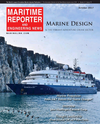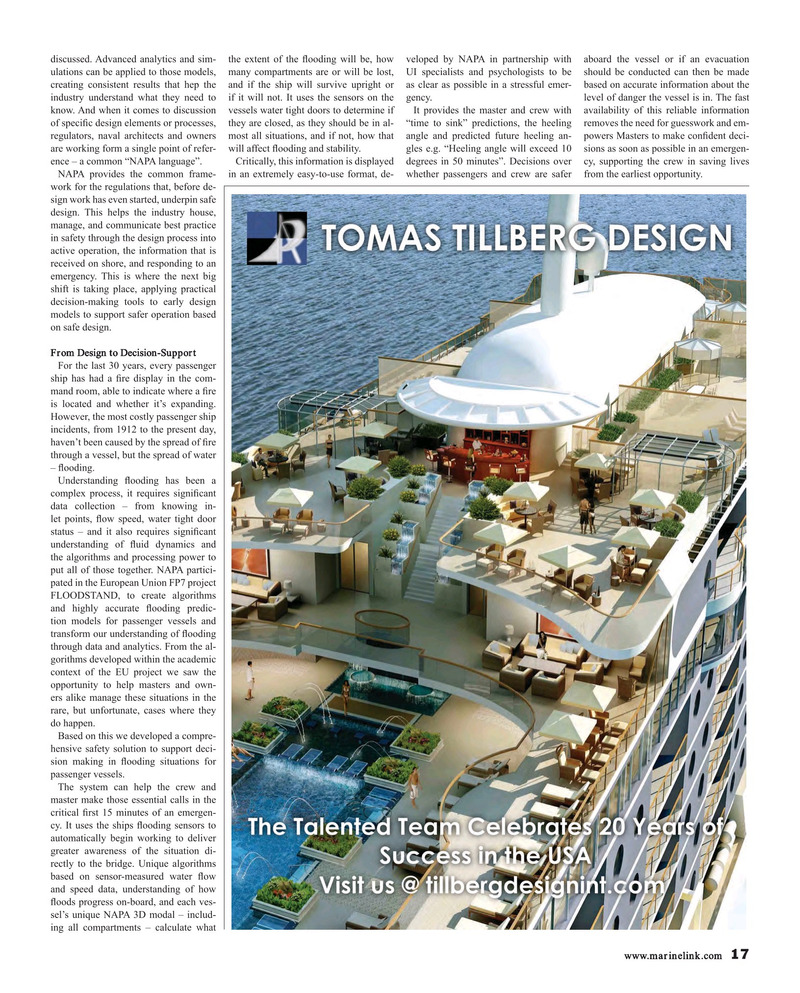
Page 17: of Maritime Reporter Magazine (October 2017)
The Marine Design Annual
Read this page in Pdf, Flash or Html5 edition of October 2017 Maritime Reporter Magazine
discussed. Advanced analytics and sim- the extent of the ? ooding will be, how veloped by NAPA in partnership with aboard the vessel or if an evacuation ulations can be applied to those models, many compartments are or will be lost, UI specialists and psychologists to be should be conducted can then be made creating consistent results that hep the and if the ship will survive upright or as clear as possible in a stressful emer- based on accurate information about the industry understand what they need to if it will not. It uses the sensors on the gency. level of danger the vessel is in. The fast know. And when it comes to discussion vessels water tight doors to determine if It provides the master and crew with availability of this reliable information of speci? c design elements or processes, they are closed, as they should be in al- “time to sink” predictions, the heeling removes the need for guesswork and em- regulators, naval architects and owners most all situations, and if not, how that angle and predicted future heeling an- powers Masters to make con? dent deci- are working form a single point of refer- will affect ? ooding and stability. gles e.g. “Heeling angle will exceed 10 sions as soon as possible in an emergen- ence – a common “NAPA language”. Critically, this information is displayed degrees in 50 minutes”. Decisions over cy, supporting the crew in saving lives
NAPA provides the common frame- in an extremely easy-to-use format, de- whether passengers and crew are safer from the earliest opportunity. work for the regulations that, before de- sign work has even started, underpin safe design. This helps the industry house, manage, and communicate best practice in safety through the design process into active operation, the information that is received on shore, and responding to an emergency. This is where the next big shift is taking place, applying practical decision-making tools to early design models to support safer operation based on safe design.
From Design to Decision-Support
For the last 30 years, every passenger ship has had a ? re display in the com- mand room, able to indicate where a ? re is located and whether it’s expanding.
However, the most costly passenger ship incidents, from 1912 to the present day, haven’t been caused by the spread of ? re through a vessel, but the spread of water – ? ooding.
Understanding ? ooding has been a complex process, it requires signi? cant data collection – from knowing in- let points, ? ow speed, water tight door status – and it also requires signi? cant understanding of ? uid dynamics and the algorithms and processing power to put all of those together. NAPA partici- pated in the European Union FP7 project
FLOODSTAND, to create algorithms and highly accurate ? ooding predic- tion models for passenger vessels and transform our understanding of ? ooding through data and analytics. From the al- gorithms developed within the academic context of the EU project we saw the opportunity to help masters and own- ers alike manage these situations in the rare, but unfortunate, cases where they do happen.
Based on this we developed a compre- hensive safety solution to support deci- sion making in ? ooding situations for passenger vessels.
The system can help the crew and master make those essential calls in the critical ? rst 15 minutes of an emergen- cy. It uses the ships ? ooding sensors to automatically begin working to deliver greater awareness of the situation di- rectly to the bridge. Unique algorithms based on sensor-measured water ? ow and speed data, understanding of how ? oods progress on-board, and each ves- sel’s unique NAPA 3D modal – includ- ing all compartments – calculate what www.marinelink.com 17
MR #10 (10-17).indd 17 MR #10 (10-17).indd 17 10/4/2017 3:04:52 PM10/4/2017 3:04:52 PM

 16
16

 18
18
